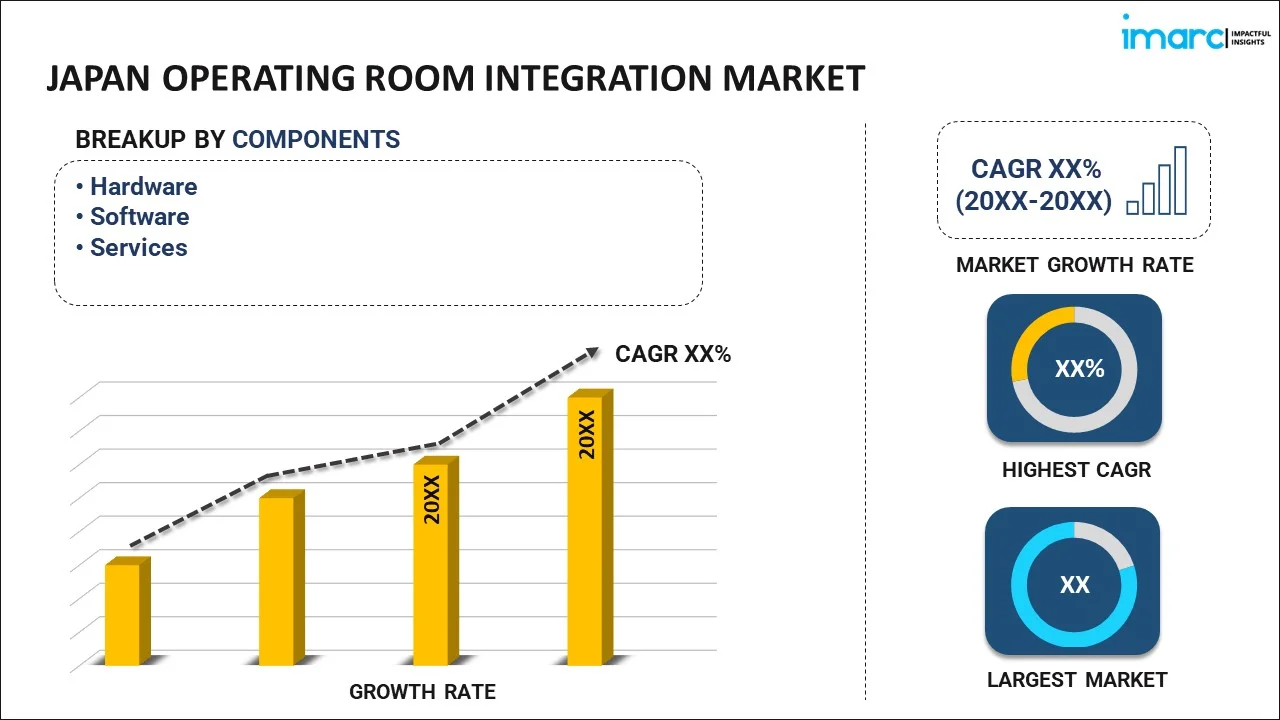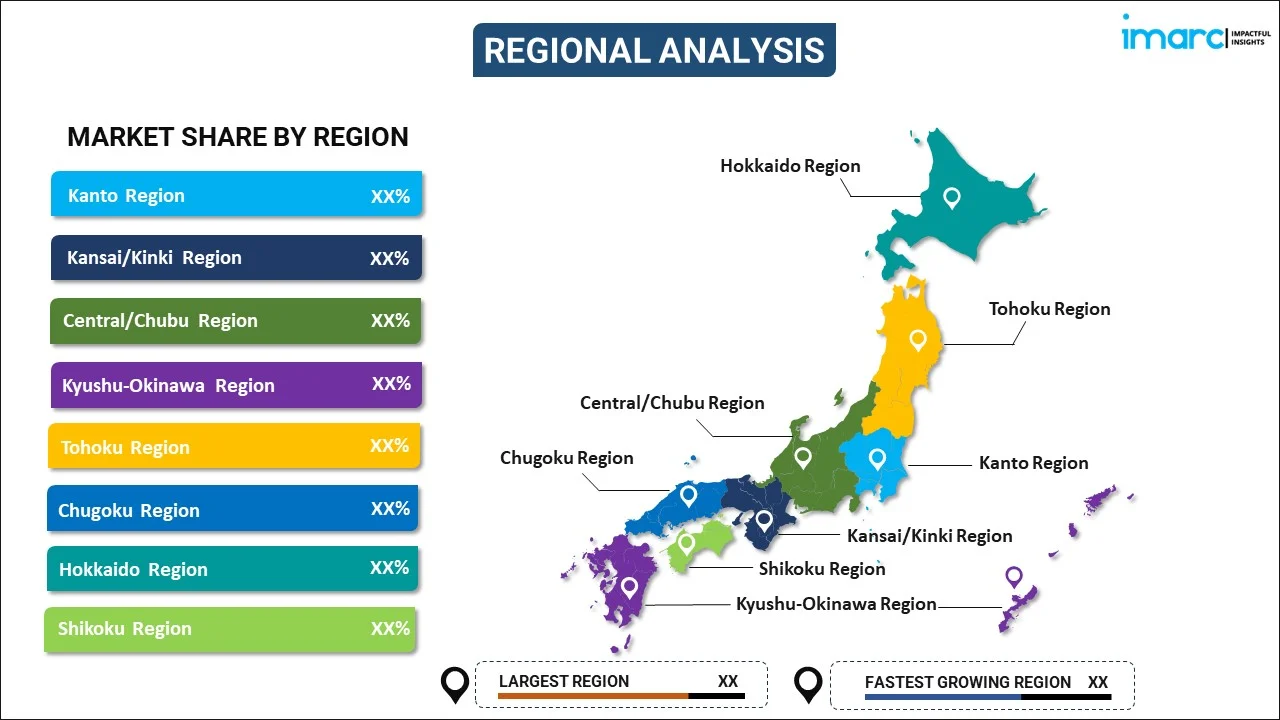
Japan Operating Room Integration Market Report by Component (Hardware, Software, Services), Device Type (Audio Video Management System, Display System, Documentation Management and Recording System, and Others), Application (General Surgery, Orthopedic Surgery, Neurosurgery, and Others), End User (Hospitals, Ambulatory Surgical Centers (ASCs), and Others), and Region 2025-2033
Market Overview:
Japan operating room integration market size reached USD 183.6 Million in 2024. Looking forward, IMARC Group expects the market to reach USD 451.0 Million by 2033, exhibiting a growth rate (CAGR) of 9.6% during 2025-2033. The emerging popularity of minimally invasive surgical procedures that require advanced operating room integration to support the use of specialized equipment like laparoscopes, endoscopes, and robotic surgical systems, is driving the market.
|
Report Attribute
|
Key Statistics
|
|---|---|
|
Base Year
|
2024
|
|
Forecast Years
|
2025-2033
|
|
Historical Years
|
2019-2024
|
| Market Size in 2024 | USD 183.6 Million |
| Market Forecast in 2033 | USD 451.0 Million |
| Market Growth Rate 2025-2033 | 9.6% |
Operating room integration (ORI) is a comprehensive medical technology solution that streamlines and enhances the functionality of operating rooms in healthcare facilities. ORI systems integrate various medical devices, such as surgical lights, anesthesia machines, imaging equipment, and electronic health records, into a cohesive and synchronized environment. These systems offer several benefits, including improved workflow efficiency, reduced human errors, and enhanced patient safety. Surgeons and medical staff can access real-time patient data, images, and vital information, enabling them to make more informed decisions during surgeries. Integrated audio and video systems facilitate communication within the operating room and can also be used for educational purposes and remote consultations. Furthermore, ORI systems can aid in documenting procedures and maintaining comprehensive patient records. They contribute to the optimization of surgical processes, minimize downtime, and promote a sterile and organized environment. ORI plays a vital role in modern healthcare, advancing surgical practices and improving patient outcomes through seamless technology integration.
Japan Operating Room Integration Market Trends:
The operating room integration market in Japan is pivotal in propelling the healthcare sector towards enhanced efficiency and patient care. Firstly, technological advancements have played a crucial role in shaping this market. With the integration of state-of-the-art equipment, healthcare providers can streamline their processes, reducing errors and improving surgical outcomes. Furthermore, the growing demand for minimally invasive procedures is driving the need for integrated OR solutions. These systems enable surgeons to access real-time data, enhancing precision and reducing recovery times. Secondly, the increasing focus on cost-efficiency and resource optimization in healthcare is a significant driver. Integrated OR solutions help hospitals and clinics make the most of their resources by optimizing workflow and reducing the need for additional staff. This cost-effective approach ensures better resource allocation. Moreover, the rising prevalence of chronic diseases and the aging population, which are boosting the demand for surgical procedures that are more efficient, safer, and patient-centric, is expected to drive the operating room integration market in Japan during the forecast period.
Japan Operating Room Integration Market Segmentation:
IMARC Group provides an analysis of the key trends in each segment of the market, along with forecasts at the country level for 2025-2033. Our report has categorized the market based on component, device type, application, and end user.
Component Insights:

- Hardware
- Software
- Services
The report has provided a detailed breakup and analysis of the market based on the component. This includes hardware, software, and services.
Device Type Insights:
- Audio Video Management System
- Display System
- Documentation Management and Recording System
- Others
A detailed breakup and analysis of the market based on the device type have also been provided in the report. This includes audio video management system, display system, documentation management and recording system, and others.
Application Insights:
- General Surgery
- Orthopedic Surgery
- Neurosurgery
- Others
The report has provided a detailed breakup and analysis of the market based on the application. This includes general surgery, orthopedic surgery, neurosurgery, and others.
End User Insights:
- Hospitals
- Ambulatory Surgical Centers (ASCs)
- Others
A detailed breakup and analysis of the market based on the end user have also been provided in the report. This includes hospitals, ambulatory surgical centers (ASCs), and others.
Regional Insights:

- Kanto Region
- Kansai/Kinki Region
- Central/ Chubu Region
- Kyushu-Okinawa Region
- Tohoku Region
- Chugoku Region
- Hokkaido Region
- Shikoku Region
The report has also provided a comprehensive analysis of all the major regional markets, which include Kanto Region, Kansai/Kinki Region, Central/ Chubu Region, Kyushu-Okinawa Region, Tohoku Region, Chugoku Region, Hokkaido Region, and Shikoku Region.
Competitive Landscape:
The market research report has also provided a comprehensive analysis of the competitive landscape. Competitive analysis such as market structure, key player positioning, top winning strategies, competitive dashboard, and company evaluation quadrant has been covered in the report. Also, detailed profiles of all major companies have been provided.
Japan Operating Room Integration Market Report Coverage:
| Report Features | Details |
|---|---|
| Base Year of the Analysis | 2024 |
| Historical Period | 2019-2024 |
| Forecast Period | 2025-2033 |
| Units | Million USD |
| Scope of the Report | Exploration of Historical Trends and Market Outlook, Industry Catalysts and Challenges, Segment-Wise Historical and Future Market Assessment:
|
| Components Covered | Hardware, Software, Services |
| Device Types Covered | Audio Video Management System, Display System, Documentation Management and Recording System, Others |
| Applications Covered | General Surgery, Orthopedic Surgery, Neurosurgery, Others |
| End Users Covered | Hospitals, Ambulatory Surgical Centers (ASCs), Others |
| Regions Covered | Kanto Region, Kansai/Kinki Region, Central/ Chubu Region, Kyushu-Okinawa Region, Tohoku Region, Chugoku Region, Hokkaido Region, Shikoku Region |
| Customization Scope | 10% Free Customization |
| Post-Sale Analyst Support | 10-12 Weeks |
| Delivery Format | PDF and Excel through Email (We can also provide the editable version of the report in PPT/Word format on special request) |
Key Questions Answered in This Report:
- How has the Japan operating room integration market performed so far and how will it perform in the coming years?
- What has been the impact of COVID-19 on the Japan operating room integration market?
- What is the breakup of the Japan operating room integration market on the basis of component?
- What is the breakup of the Japan operating room integration market on the basis of device type?
- What is the breakup of the Japan operating room integration market on the basis of application?
- What is the breakup of the Japan operating room integration market on the basis of end user?
- What are the various stages in the value chain of the Japan operating room integration market?
- What are the key driving factors and challenges in the Japan operating room integration?
- What is the structure of the Japan operating room integration market and who are the key players?
- What is the degree of competition in the Japan operating room integration market?
Key Benefits for Stakeholders:
- IMARC’s industry report offers a comprehensive quantitative analysis of various market segments, historical and current market trends, market forecasts, and dynamics of the Japan operating room integration market from 2019-2033.
- The research report provides the latest information on the market drivers, challenges, and opportunities in the Japan operating room integration market.
- Porter's five forces analysis assist stakeholders in assessing the impact of new entrants, competitive rivalry, supplier power, buyer power, and the threat of substitution. It helps stakeholders to analyze the level of competition within the Japan operating room integration industry and its attractiveness.
- Competitive landscape allows stakeholders to understand their competitive environment and provides an insight into the current positions of key players in the market.
Need more help?
- Speak to our experienced analysts for insights on the current market scenarios.
- Include additional segments and countries to customize the report as per your requirement.
- Gain an unparalleled competitive advantage in your domain by understanding how to utilize the report and positively impacting your operations and revenue.
- For further assistance, please connect with our analysts.
 Inquire Before Buying
Inquire Before Buying
 Speak to an Analyst
Speak to an Analyst
 Request Brochure
Request Brochure
 Request Customization
Request Customization




.webp)




.webp)












